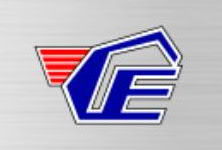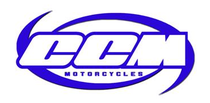
Motorenwerke Zschopau GmbH is a German motorcycle manufacturer located in Zschopau, Saxony. The acronym MZ since 1956 stands for Motorenwerke Zschopau GmbH. From 1992 to 1999 the company was called MuZ, an acronym for Motorrad und Zweiradwerk.

KTM is an Austrian motorcycle, bicycle and motorsports brand which is co-owned by Indian manufacturer Bajaj Auto and Austrian manufacturer Pierer Mobility AG. It traces its foundation in 1934 as Kronreif & Trunkenpolz Mattighofen. Today, Pierer Mobility AG operates as the manufacturer of KTM branded motorcycles; whereas KTM Fahrrad AG operates as the manufacturer of KTM branded bicycles.

Motocross is a form of off-road motorcycle racing held on enclosed off-road circuits. The sport evolved from motorcycle trials competitions held in the United Kingdom.
Cagiva is an Italian motorcycle manufacturer. It was founded in 1950 by Giovanni Castiglioni in Varese, originally producing small metal components. Giovanni's sons, Claudio and Gianfranco Castiglioni, went into the motorcycle industry in 1978. The name is a portmanteau derived from the founder's name 'Giovanni Castiglioni' and the founding location, i.e. Castiglioni Giovanni Varese.

A motorcycle engine is an engine that powers a motorcycle. Motorcycle engines are typically two-stroke or four-stroke internal combustion engines, but other engine types, such as Wankels and electric motors, have been used.

In the market, there is a wide variety of types of motorcycles, each with unique characteristics and features. Models vary according to the specific needs of each user, such as standard, cruiser, touring, sports, off-road, dual-purpose, scooters, etc. Often, some types like sport touring are considered as an additional category or integrated with touring.

Husaberg was a manufacturer of enduro motorcycles with four and two-stroke engines, the displacements ranging from 125 cc to 650 cc. Originally based in Sweden, its motorcycles were later manufactured in Austria by parent company KTM until the line was retired in 2014.
ATK is an American motorcycle and all-terrain vehicle company founded in 1985 and located in Centerville, Utah, USA. As of 2016, it has been operating primarily to support previously sold models through parts and service manual distribution. While ATK was initially founded on in-house chassis designs and modified sourced engines, the brand has primarily focused on acquisition and badge-engineered models from multiple companies worldwide since 2004.

SV.VM was an Italian motorcycle manufacturer founded in 1971 by Piero Sironi and Fausto Vergani. Based in Milan, SWM manufactured Observed Trials, Enduro, Motocross and off-road motorcycles in the 1970s and 1980s. They started with small capacity Sachs engined enduro bikes and began making Rotax engined trials bikes in 1977. The other main manufacturers at this time included Fantic Motor, Bultaco and Montesa.

Unit construction is the design of larger motorcycles where the engine and gearbox components share a single casing. This sometimes includes the design of automobile engines and was often loosely applied to motorcycles with rather different internal layouts such as the flat twin BMW models.

Associated Motor Cycles (AMC) was a British motorcycle manufacturer founded by the Collier brothers as a parent company for the Matchless and AJS motorcycle companies. It later absorbed Francis-Barnett, James, and Norton before incorporation into Norton-Villiers. Henry Herbert Collier founded Matchless as a cycle company in 1878. His sons Henry (Harry) and Charles (Charlie) joined him and the name was changed to H. Collier & Sons.

The BSA Gold Star is a motorcycle made by BSA from 1938 to 1963. They were 350 cc and 500 cc single-cylinder four-stroke production motorcycles known for being among the fastest bikes of the 1950s. Being hand built and with many optional performance modifications available, each motorcycle came from the factory with documented dynamometer test results, allowing the new owner to see the horsepower (bhp) produced.

The Harley-Davidson WLA is a Harley-Davidson motorcycle that was produced to US Army specifications in the years during and around World War II. It was based on an existing civilian model, the WL, and is of the 45 solo type, so called due to its 45-cubic-inch (740 cm3) engine displacement and single-rider design. It acquired the nickname "Liberator".

Husqvarna Motorcycles GmbH is an Austrian company which designs, engineers, manufactures and distributes motocross, enduro, supermoto and street motorcycles.

Armstrong-CCM Motorcycles was a British motorcycle manufacturer based in Bolton, England. Alan Clews formed CCM in 1971 from what was left of BSA's off-road competition team and bought spares to produce his own motorcycles. Later, its Bolton factory was established.

Cheney Racing is a British motorcycle manufacturer, founded by Eric Cheney, based in Petersfield, Hampshire which builds complete specialist high performance motocross motorcycles, rolling chassis or frame kits to individual customer specifications.
The BSA B50 was a single-cylinder 499 cc (30.5 cu in) ohv motorcycle, produced by BSA at their factory in Small Heath, Birmingham. The last of the big capacity unit-construction singles from the Birmingham Small Arms company, it had an alloy engine with a bore of 84 mm (3.3 in) and a stroke of 90 mm (3.5 in). As well as the road version, special models were produced for off-road competition use.

The following outline is provided as an overview of motorcycles and motorcycling:

BSA motorcycles were made by the Birmingham Small Arms Company Limited (BSA), which was a major British industrial combine, a group of businesses manufacturing military and sporting firearms; bicycles; motorcycles; cars; buses and bodies; steel; iron castings; hand, power, and machine tools; coal cleaning and handling plants; sintered metals; and hard chrome process.

The BSA B44 was a series of 441 cc (26.9 cu in) unit construction single-cylinder OHV four-stroke motorcycles made by the Birmingham Small Arms Company between 1966 and 1970. The machines were developed from the BSA World Championship Motocross machines, which were themselves based on the C15/B40.


















